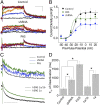hERG 1b is critical for human cardiac repolarization
- PMID: 25453103
- PMCID: PMC4273358
- DOI: 10.1073/pnas.1414945111
hERG 1b is critical for human cardiac repolarization
Abstract
The human ether-à-go-go-related gene (hERG; or KCNH2) encodes the voltage-gated potassium channel underlying IKr, a repolarizing current in the heart. Mutations in KCNH2 or pharmacological agents that reduce IKr slow action potential (AP) repolarization and can trigger cardiac arrhythmias associated with long QT syndrome. Two channel-forming subunits encoded by KCNH2 (hERG 1a and 1b) are expressed in cardiac tissue. In heterologous expression systems, these subunits avidly coassemble and exhibit biophysical and pharmacological properties distinct from those of homomeric hERG 1a channels. Despite these findings, adoption of hERG 1a/1b heteromeric channels as a model for cardiac IKr has been hampered by the lack of evidence for a direct functional role for the 1b subunit in native tissue. In this study, we measured IKr and APs at physiological temperature in cardiomyocytes derived from human induced pluripotent stem cells (iPSC-CMs). We found that specific knockdown of the 1b subunit using shRNA caused reductions in 1b mRNA, 1b protein levels, and IKr magnitude by roughly one-half. AP duration was increased and AP variability was enhanced relative to controls. Early afterdepolarizations, considered cellular substrates for arrhythmia, were also observed in cells with reduced 1b expression. Similar behavior was elicited when channels were effectively converted from heteromers to 1a homomers by expressing a fragment corresponding to the 1a-specific N-terminal Per-Arnt-Sim domain, which is omitted from hERG 1b by alternate transcription. These findings establish that hERG 1b is critical for normal repolarization and that loss of 1b is proarrhythmic in human cardiac cells.
Keywords: KCNH2; arrhythmia; early afterdepolarization; hERG; long QT syndrome.
Conflict of interest statement
The authors declare no conflict of interest.
Figures




Similar articles
-
Dominant negative consequences of a hERG 1b-specific mutation associated with intrauterine fetal death.Prog Biophys Mol Biol. 2016 Jan;120(1-3):67-76. doi: 10.1016/j.pbiomolbio.2016.01.002. Epub 2016 Jan 6. Prog Biophys Mol Biol. 2016. PMID: 26772437 Free PMC article.
-
Tbx20 controls the expression of the KCNH2 gene and of hERG channels.Proc Natl Acad Sci U S A. 2017 Jan 17;114(3):E416-E425. doi: 10.1073/pnas.1612383114. Epub 2017 Jan 3. Proc Natl Acad Sci U S A. 2017. PMID: 28049825 Free PMC article.
-
Physiological properties of hERG 1a/1b heteromeric currents and a hERG 1b-specific mutation associated with Long-QT syndrome.Circ Res. 2008 Sep 26;103(7):e81-95. doi: 10.1161/CIRCRESAHA.108.185249. Epub 2008 Sep 5. Circ Res. 2008. PMID: 18776039 Free PMC article.
-
Computational Models for Understanding of Structure, Function and Pharmacology of the Cardiac Potassium Channel Kv11.1 (hERG).Curr Top Med Chem. 2017;17(23):2681-2702. doi: 10.2174/1568026617666170414143430. Curr Top Med Chem. 2017. PMID: 28413954 Review.
-
Facilitation of hERG Activation by Its Blocker: A Mechanism to Reduce Drug-Induced Proarrhythmic Risk.Int J Mol Sci. 2023 Nov 13;24(22):16261. doi: 10.3390/ijms242216261. Int J Mol Sci. 2023. PMID: 38003453 Free PMC article. Review.
Cited by
-
Effects of Temperature on Heteromeric Kv11.1a/1b and Kv11.3 Channels.Biophys J. 2016 Aug 9;111(3):504-523. doi: 10.1016/j.bpj.2016.07.002. Biophys J. 2016. PMID: 27508435 Free PMC article.
-
hERG1 channel subunit composition mediates proton inhibition of rapid delayed rectifier potassium current (IKr) in cardiomyocytes derived from hiPSCs.J Biol Chem. 2023 Feb;299(2):102778. doi: 10.1016/j.jbc.2022.102778. Epub 2022 Dec 8. J Biol Chem. 2023. PMID: 36496073 Free PMC article.
-
Molecular dynamics simulations suggest possible activation and deactivation pathways in the hERG channel.Commun Biol. 2022 Feb 24;5(1):165. doi: 10.1038/s42003-022-03074-9. Commun Biol. 2022. PMID: 35210539 Free PMC article.
-
Zebrafish cardiac repolarization does not functionally depend on the expression of the hERG1b-like transcript.Pflugers Arch. 2024 Jan;476(1):87-99. doi: 10.1007/s00424-023-02875-z. Epub 2023 Nov 7. Pflugers Arch. 2024. PMID: 37934265
-
CardioGenAI: a machine learning-based framework for re-engineering drugs for reduced hERG liability.J Cheminform. 2025 Mar 5;17(1):30. doi: 10.1186/s13321-025-00976-8. J Cheminform. 2025. PMID: 40045386 Free PMC article.
References
-
- Sanguinetti MC, Jiang C, Curran ME, Keating MT. A mechanistic link between an inherited and an acquired cardiac arrhythmia: HERG encodes the IKr potassium channel. Cell. 1995;81(2):299–307. - PubMed
-
- Trudeau MC, Warmke JW, Ganetzky B, Robertson GA. HERG, a human inward rectifier in the voltage-gated potassium channel family. Science. 1995;269(5220):92–95. - PubMed
-
- Curran ME, et al. A molecular basis for cardiac arrhythmia: HERG mutations cause long QT syndrome. Cell. 1995;80(5):795–803. - PubMed
-
- Food and Drug Administration, HHS International Conference on Harmonisation; guidance on S7B Nonclinical Evaluation of the Potential for Delayed Ventricular Repolarization (QT Interval Prolongation) by Human Pharmaceuticals; availability. Notice. Fed Regist. 2005;70(202):61133–61134. - PubMed
-
- Snyders DJ, Chaudhary A. High affinity open channel block by dofetilide of HERG expressed in a human cell line. Mol Pharmacol. 1996;49(6):949–955. - PubMed
Publication types
MeSH terms
Substances
Grants and funding
LinkOut - more resources
Full Text Sources
Other Literature Sources
Miscellaneous

